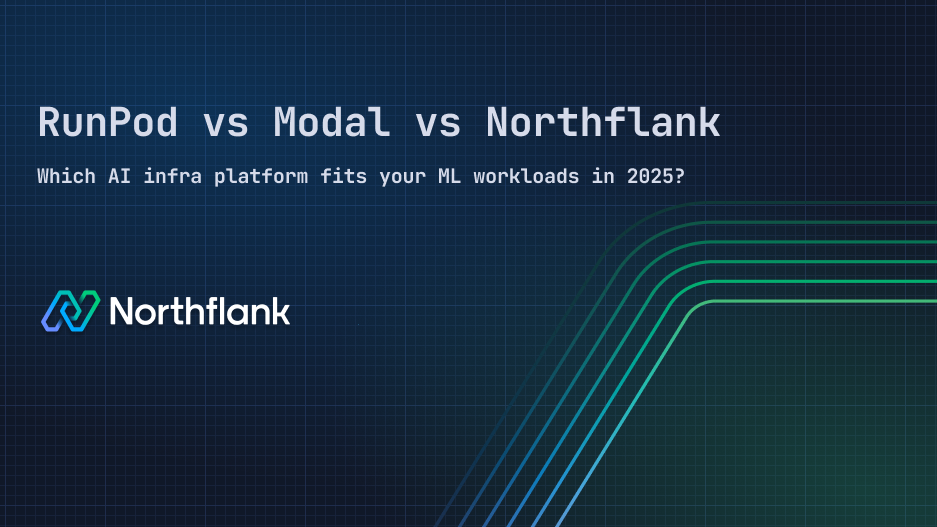

RunPod vs Modal: Which AI infra platform fits your ML workloads in 2025?
If your team is deciding between RunPod and Modal, you're most likely building or scaling an AI product and need to move fast.
Both platforms have made GPU access simpler, reducing the amount of complexity that comes with ML infrastructure.
When you go beyond model inference, things become more involved because you now need to:
- fine-tune models
- run background jobs
- serve APIs
- connect to services like Postgres and Redis
...all while keeping everything secure and cost-efficient.
That’s when the question comes up: are we only serving models, or are we building full applications that include everything around them?
In this article, we’ll look at how RunPod and Modal compare, and where Northflank fits in if your team needs a more complete setup for building and running AI workloads.
Before we break things down further, below is a side-by-side comparison of how RunPod, Modal, and Northflank compare across features your team might care about.
💡Looking to deploy more than just models?
Try Northflank for free or book a demo to see how we support full AI workloads, including databases, CI/CD, and GPU provisioning, in one place.
Need help choosing between platforms? If you're evaluating GPU platforms and have specific capacity or availability requirements, request GPU capacity here.
| Feature / Capability | RunPod | Modal | Northflank |
|---|---|---|---|
| GPU access | Spot and on-demand GPUs | Managed and autoscaling GPUs | GPU support with BYOC or on-demand |
| Inference serving | Via community templates | Code-defined (Python-first) | Yes – REST/gRPC endpoints, custom APIs |
| Fine-tuning support | Manual via container deployments | Yes | Yes – PyTorch, DeepSpeed, custom jobs |
| Jupyter Notebooks | Yes (via template) | Yes | Yes – with templates or primitives |
| Orchestration (jobs, pipelines) | Yes | Built-in for Python-based flows | Native job scheduling and CI/CD pipelines |
| Multi-tenant security | Basic isolation in shared environments; Secure Cloud for sensitive workloads | Hosted multi-tenant architecture with shared GPU resource pooling | Secure runtime with isolation and RBAC |
| CI/CD support | No built-in pipelines, but can be integrated via API (e.g., GitHub Actions) | No built-in pipelines, but supports CI/CD via GitHub Actions and APIs | Built-in CI/CD with Git-based deploys |
| Networking control | Basic container networking | Abstracted networking | Static IPs, custom domains, MTLS |
| Bring your own cloud (BYOC) | No | No | Yes – supports hybrid and custom GPU providers |
| Compliance (SOC 2, etc.) | SOC 2 Type 1 achieved; Type 2 in progress (as of Feb 2025) | SOC 2 Type II compliant (as of Jan 2025) | SOC 2 roadmap, audit logs, SAML, RBAC |
| Pricing model | Per-GPU usage | Per-call or per-function pricing | Per-container/minute, with project-based billing |
| Templates / easy deploy | Community-made | Code-driven | Northflank templates and GitOps config |
Now that you've seen the comparison, let’s start with RunPod if your focus is fast GPU access and you prefer handling infrastructure your own way.

RunPod is popular among researchers and indie devs for a reason. It gives you spot and on-demand GPU instances with transparent pricing, and you get to run your own containers on top. You control what runs, how it runs, and where your workloads live.
If your team is building custom ML workflows and you're comfortable managing orchestration manually, this setup can work well.
What you get with RunPod:
- Fast access to GPUs at low cost, particularly when using spot instances
- Full control over your containers without being tied to a specific framework
- Community templates for tools like Jupyter, LLaMA, and Stable Diffusion
You can also see RunPod alternatives for AI/ML deployment beyond just a container
If RunPod gives you low-level control, Modal takes the opposite approach. It’s designed to feel like part of your Python workflow, with minimal setup, clean abstractions, and no need to think about containers or orchestration.

You write Python functions and register them with a decorator that tells Modal to run the code remotely with autoscaling. It works well for serving inference endpoints without having to manage infrastructure.
What you get with Modal:
- A code-first experience tailored for Python developers
- Autoscaling is built in, so you don’t need to handle resource allocation
- Simple setup for running lightweight model serving workloads
The abstraction is helpful if your use case fits what Modal is built for. If your workload lives entirely in Python and you want to deploy quickly without touching containers, Modal can be a good fit.
RunPod gives you low-level control. Modal gives you clean abstractions. Still, if you’re building something that needs to scale, GPU access on its own might not be enough.
A few questions to ask as your stack gets more complex:
- Do you need to run background jobs or long-running processes?
- Are services like vector databases, Postgres, or Redis part of your architecture?
- Do you want built-in CI/CD, logs, metrics, or preview environments to speed up iteration?
- Can you deploy in your own cloud, or do you need to?
- Is secure multi-tenancy important for your team or your users?
If you answered yes to more than one of these, it might be time to think beyond single-purpose tools. That’s where Northflank fits in.
If your team is looking to run more than models, including APIs, queues, databases, and jobs, this is where Northflank comes in.

Northflank is built as a unified platform, not only for AI workloads but also for everything around them. You can deploy model servers, fine-tuning jobs, Jupyter notebooks, and long-running workers right alongside your database, Redis instance, or Postgres service, all in one place.
What this looks like in practice:
- Run fine-tuning jobs using PyTorch or DeepSpeed
- Host APIs, background workers, and cron jobs together
- Spin up Jupyter notebooks using templates or configure from Git
- Use built-in services like Postgres, Redis, and Mongo without leaving the platform
- Choose between templates for fast deploys or use primitives for full control
- Get GPU provisioning in under 30 minutes across providers
- Deploy in your own cloud with BYOC or run hybrid across multiple regions
- Schedule jobs, manage pipelines, and track builds with built-in CI/CD
- Stay on top of logs, metrics, and audit trails for every workload
- Protect your users with a secure runtime and full multi-tenant isolation
This makes Northflank a good fit when your AI workloads are only part of the stack, and you need consistency across the rest.
💡Get started by deploying your first GPU workload on Northflank for free, or book a call with our team to walk through your use case.
At this point, it depends on what you're building and how much control you need.
- Go with RunPod if you want low-level access to GPUs and are managing the rest of the infrastructure yourself. It’s a reliable option for custom setups where cost and flexibility are the priority.
- Go with Modal if you're focused on deploying inference endpoints with minimal setup and your workflow is fully Python-based. It works well for smaller, isolated use cases.
- Go with Northflank if you're running both models and the application logic around them. It gives you a secure, unified environment with GPU provisioning, BYOC, CI/CD, databases, and multi-tenant support, all in one platform.
Each platform serves a different need. The best fit comes down to how much you want to manage and how complete your deployment environment needs to be.